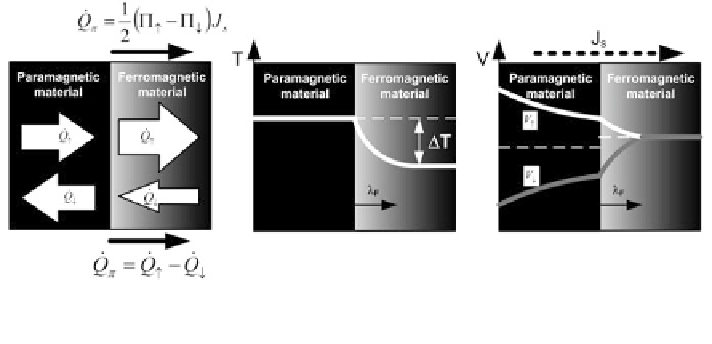Environmental Engineering Reference
In-Depth Information
Fig. 6.8 An example of the spin-Peltier effect in a paramagnetic/ferromagnetic pair (see also
45
,
51
,
52
)
The system in the Fig.
6.7
consists of a thin-
lm ferromagnetic material (e.g. Ni,
Fe) and a thin-
eld H is applied
along the ferromagnetic sample, as well as the temperature gradient. In a ferromag-
netic metal under a temperature gradient, the thermally induced spin voltage
l "
l #
lm Pt material. In this particular case the magnetic
induces a spin current in the direction of the interface surface ferromagnetic
material (Ni or Fe in this case)
paramagnetic material Pt. This spin current in the
paramagnetic material (i.e. Pt) generates the electromotive force or electric voltage.
In the case of the spin-Peltier effect (Fig.
6.8
) the spin current is driven through the
interface between the paramagnetic metal and the ferromagnetic metal [
45
,
51
,
52
].
In a paramagnetic metal, the Peltier heat current for both spin species is equal
[
45
,
51
,
52
]. In two spin channels, the
—
ow direction of two heat currents ( Q
"
and
Q
#
) is opposite, so the total heat current equals zero. However, in a ferromagnetic
material, the heat currents are different. A consequence of this is the net heat current
from the interface into the ferromagnetic material or the net heat current from the
ferromagnetic material towards the interface. In Fig.
6.8
the spin current Js = J
↑
−
fl
J
↓
is driven from the paramagnetic material across the interface, into the ferromagnetic
material. In this particular case there is no charge current (J
↑
+J
↓
= 0) and a net heat
fl
ow can be observed in the ferromagnetic material. This leads to a temperature
gradient between the paramagnetic and the ferromagnetic material. Note that the net
heat
ow rapidly drops due to the spin relaxation length
k
F
. The spin relaxation
length (or spin diffusion length) denotes a kind of electron memory for the spin
direction and it signi
fl
cantly exceeds the mean free path.
6.2.4 Active and Passive Mechanical Contact-Based
Thermal Diodes
These types of thermal diodes relate to the different properties of materials and
mechanisms, for example, the piezoelectric, shape-memory effect and others. The

Search WWH ::

Custom Search